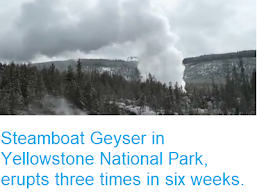The Giantess Geyser in Yellowstone National Park errupted on Tuesday 25 August 2020, producing a jet of water about 60 m high. This is the first time the geyser has errupted in six and a half years. This is an long pause between eruptions for Giantess, which typically erupts 2-6 times per year, but not unusually so; the geyser is known to have periodic multi-year hiatuses with the last having happened in the 1980s. Giantess is the second largest in the Yellowstone National Park, after the Steamboat Geyser, whih is the largest in North America and the second largest in the world.
Erruption of Giantess Geyser on 25 August 2020. Yellowstone National Park.
The Yellowstone National Park lies on top of the caldera of an active volcano. The geysers and hot springs are fuelled by water from the surface peculating through the ground until it encounters hot rocks or magma, which heats it rapidly. This hot water then rises back to the surface to fuel the geysers and fill the volcanic pools of the park. As it passes through the rocks the water absorbs chemicals from the surrounding minerals, with water with different mineral properties in different parts of the park, creating a variety of brightly coloured pools.
See also...


Follow Sciency Thoughts on Facebook.





